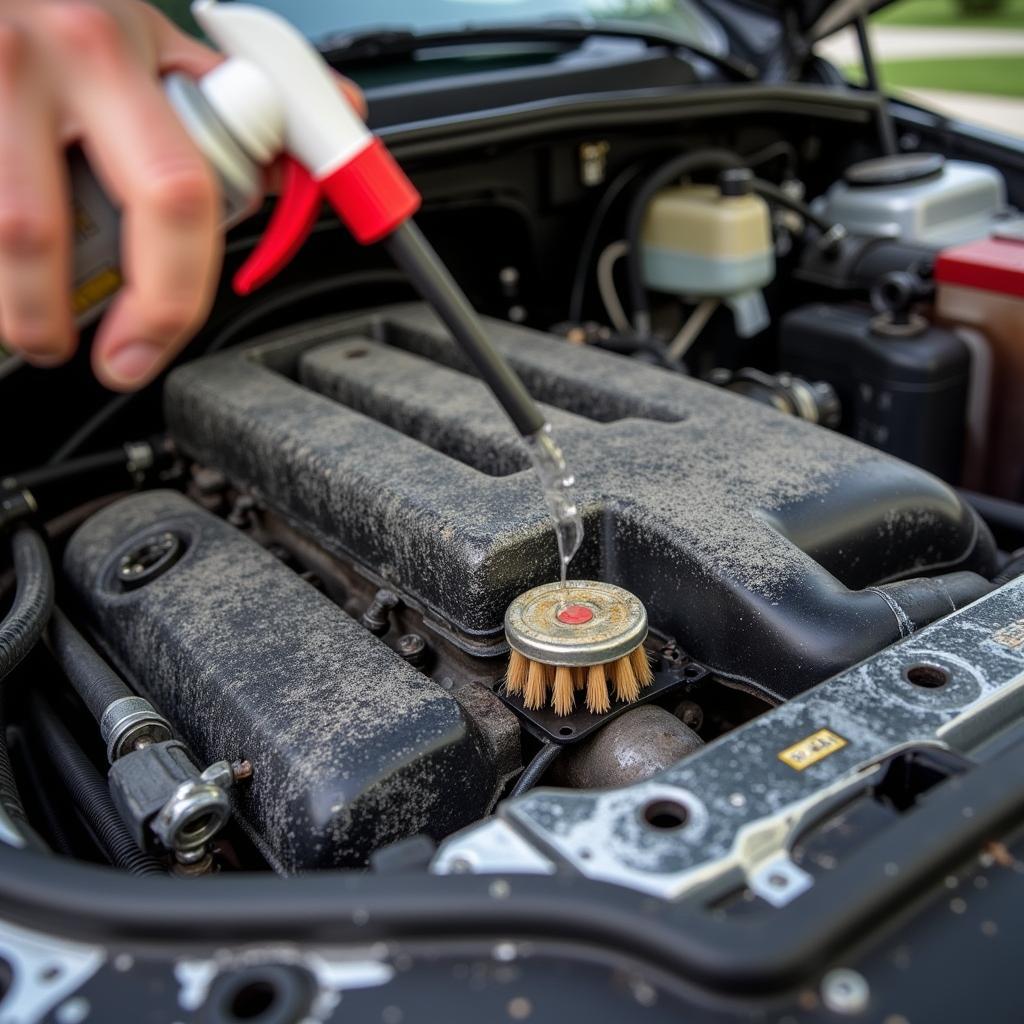A clean engine bay not only looks impressive but also contributes to the longevity and performance of your vehicle. Knowing How To Clean And Detail A Car Engine properly can save you money and enhance your car’s resale value. This guide provides a comprehensive step-by-step process for detailing your car engine like a pro.
Knowing how to detail a car engine effectively not only enhances its appearance but can also help identify potential leaks or worn components. A regular engine cleaning routine can prevent the buildup of grease and grime that can damage engine components over time. It’s an essential part of car maintenance that often gets overlooked. Want a truly perfect detail? Check out how to do the perfect car detail.
Preparing Your Engine for Cleaning
Before you begin, gather your supplies: engine degreaser, various brushes (detailing brushes, toothbrush), a garden hose with a spray nozzle, microfiber towels, plastic bags, and masking tape. Safety is paramount, so ensure the engine is cool before starting.
Protecting Sensitive Components
Cover sensitive components like the alternator, air intake, and distributor with plastic bags secured by masking tape. This prevents water damage and ensures these critical parts remain dry. This step is crucial in how to clean and detail a car engine safely and effectively.
Degreasing the Engine Bay
Apply the engine degreaser liberally to all greasy surfaces, allowing it to dwell for the recommended time. Avoid spraying directly onto electrical components. Agitate the degreaser with a brush, focusing on areas with heavy grime buildup.
Rinsing and Drying
Once the degreaser has worked its magic, rinse the engine bay thoroughly with a gentle stream of water. Avoid using high-pressure washers as they can force water into sensitive areas. After rinsing, dry the engine bay with microfiber towels. A leaf blower can expedite the drying process.
 Engine Bay Degreasing Process
Engine Bay Degreasing Process
Detailing the Engine Components
With the engine clean and dry, you can now focus on the details. Use a detailing brush and all-purpose cleaner to clean individual components like hoses, wires, and plastic covers. Pay attention to hard-to-reach areas.
Dressing and Protecting
Apply engine dressing to plastic and rubber components to restore their original shine and protect them from future grime buildup. Use a microfiber applicator pad for even coverage. This final step enhances the overall appearance of the engine bay.
Looking to detail the rest of your car? Learn how to detail paint on a car. It will make your car look showroom-ready!
Maintaining a Clean Engine
Regularly cleaning your engine bay prevents the buildup of grime and makes future detailing easier. A quick wipe-down with a damp cloth every few weeks can keep your engine looking its best. Wondering about waxing? Find out does car detailing include waxing.
Regular Checks and Inspections
While cleaning, take the opportunity to inspect for any leaks, loose hoses, or worn components. Early detection can prevent costly repairs down the line. A clean engine makes it much easier to spot potential issues.
How Much Does Professional Engine Cleaning Cost?
The cost of a professional engine cleaning can vary depending on your location and the condition of your engine. Need more pricing information? Check out how much should i charge for car detailing. Looking for local detailers? We can help you find out where can i get my car detailed around me.
In conclusion, learning how to clean and detail a car engine is a valuable skill that not only improves your car’s appearance but also contributes to its overall health and longevity. Regular engine cleaning allows for easy identification of potential problems and can prevent costly repairs. A clean engine bay is a testament to a well-maintained vehicle.
FAQ
-
How often should I clean my car engine? Every 3-6 months, or more frequently if driving in dusty or off-road conditions.
-
Can I use a pressure washer? It’s best to avoid high-pressure washers as they can damage sensitive components.
-
What type of degreaser should I use? Choose a degreaser specifically designed for automotive engines.
-
Is engine dressing necessary? Engine dressing protects and enhances the appearance of engine components.
-
What if I get water in the air intake? Allow the engine to dry completely before starting it.
Need more help with car detailing or diagnostics? Contact us via WhatsApp: +1(641)206-8880 or Email: [email protected]. We have a 24/7 customer service team ready to assist you.

Leave a Reply